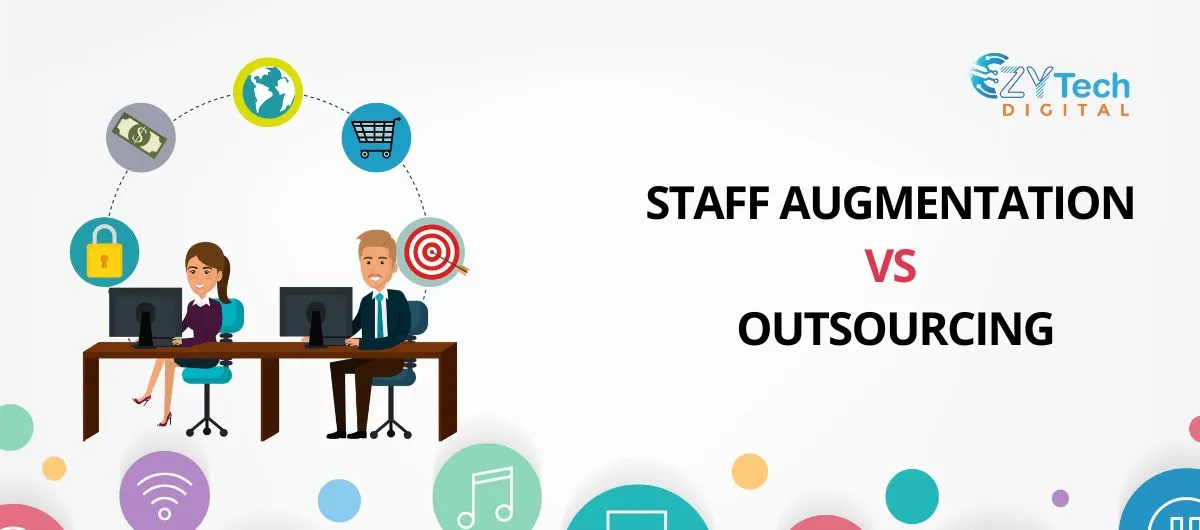
- April 14, 2025
- admin
- 0
When I began looking for ways to scale my tech team, I kept hearing about staff augmentation vs outsourcing. At first, they seemed similar—both help bring in external talent. But soon, I realized they serve very different purposes. One gives you full control and flexibility, while the other handles entire projects for you.
As a business owner trying to scale my tech team and take on bigger projects, I often faced a dilemma: Should I go with staff augmentation or fully outsource my software development needs? After years of building products, hiring remote developers, and partnering with tech vendors across the globe, I’ve learned what works and what doesn’t.
I’m sharing everything I know about staff augmentation vs outsourcing based on real-life experience. If you’re looking to hire offshore developers, build scalable development teams, or simply understand the best way to extend your IT capabilities, this article will help you make an informed decision.
What Is Staff Augmentation? My Experience Explained
Staff augmentation is when you add skilled external developers or tech professionals to your existing in-house team to help meet business goals. The hired staff become part of your team—either on-site or remote—but are officially employed by a third-party vendor.
I used staff augmentation when my startup needed more backend developers to speed up our product roadmap. We already had a solid internal engineering team, but we needed help with performance optimization, database scaling, and bug fixes. Staff augmentation allowed me to plug in extra expertise fast, without hiring full-time employees.
Contact us now for a free consultation!

What Is Outsourcing? My Honest Take
Outsourcing, unlike staff augmentation, means delegating an entire project or a defined set of tasks to an external agency or team. The outsourcing partner is responsible for managing the team, timelines, quality, and final delivery.
I outsourced a complete mobile app development project to an overseas company when I didn’t have the internal bandwidth to handle it. While it saved me time, it came with challenges around communication, quality control, and scope creep.
Key Differences Between Staff Augmentation vs Outsourcing
Let’s compare staff augmentation vs outsourcing side-by-side, based on my personal experience:
| Aspect | Staff Augmentation | Outsourcing |
| Control | I managed the team directly | Vendor managed everything |
| Flexibility | High – I could scale up/down based on needs | Limited – Locked into project-based contracts |
| Cost Transparency | Transparent hourly/daily rates | Prone to hidden costs or change orders |
| Integration | Developers integrated with our tools and workflows | Team used their systems and processes |
| Communication | Easy to manage via Slack, Jira, Zoom | Sometimes delayed or lost in translation |
| Best Use Case | When you have a core team and need extra support | When you lack in-house expertise or time |
Pros and Cons of Staff Augmentation (From My Use Cases)
Pros:
- Flexibility to Scale Development Teams Quickly I was able to ramp up my dev team within a week, which would’ve taken months through traditional hiring.
- Cost-Effective Talent Acquisition Hiring offshore developers from India and Eastern Europe allowed me to control labor costs without compromising quality.
- Access to Specialized Skills I found Python developers, React experts, and QA engineers who hit the ground running with minimal onboarding.
- Full Project Control I retained ownership of architecture, design decisions, sprint planning, and deadlines.
Cons:
- Management Overhead I still had to manage augmented developers daily—no hand-holding like in outsourcing.
- Cultural and Time Zone Barriers While manageable, I needed to schedule meetings at odd hours due to time differences.
- Security Concerns I had to provide external devs access to source code, raising some IP protection worries.
Pros and Cons of Outsourcing Based on My Experience
Pros:
- Complete Ownership by Vendor Once the contract was signed, the outsourcing partner handled everything—from wireframes to final deployment.
- Faster Time-to-Market for Standalone Projects Ideal when I need to launch an MVP without distracting my internal team.
- Focusing on Core Business Outsourcing allowed me to spend more time on growth, marketing, and fundraising.
Cons:
- Less Control Over Code and Process I couldn’t monitor sprint progress closely and often had to request updates.
- Quality Issues and Scope Creep Despite clear documentation, deliverables weren’t always up to standard, and extra features cost extra.
- Vendor Lock-in Risk Switching vendors mid-project was difficult and expensive.
When Should You Choose Staff Augmentation?
Based on my journey, I’d recommend IT staff augmentation if:
- You already have a technical team but need extra hands for a short- or medium-term project.
- You want to retain control over your architecture, timelines, and deployment.
- You need to access niche skill sets (e.g., AI, blockchain, AR/VR) temporarily.
- You’re building a long-term product and want cohesive collaboration.
Best use cases for staff augmentation:
- Scaling agile software development teams
- Fixing bugs and optimizing performance
- Adding QA and DevOps engineers temporarily
- Meeting tight project deadlines
When Should You Consider Outsourcing Instead?
Outsourcing is better if: Staff Augmentation vs Outsourcing
- You have a non-core project (e.g., CMS setup, mobile app for internal use).
- You lack an internal dev team or project management capability.
- You want to launch an MVP quickly without recruiting engineers.
- Your company is resource-constrained and prefers a fixed-bid contract.
Best use cases for outsourcing software development:
- Web and mobile app development
- E-commerce site development
- Legacy system migration
- Ongoing maintenance and support
My Preferred Model: Offshore Staff Augmentation 2.0
After experimenting with both, I discovered a third option that offered the best of both worlds: dedicated offshore developers via a staff augmentation partner. Think of it as Offshoring 2.0.
This model gave me:
- Pre-vetted developers aligned with my tech stack and culture
- Zero overhead on hiring, HR, payroll, compliance, or infrastructure
- Long-term continuity, unlike traditional freelance staff
- Hands-on control, just like my in-house team
It was like having my own offshore R&D office, without the hassle.

How I Made Staff Augmentation Work for Me
Here’s what I did to ensure success with augmented staff:
- Onboarded Developers Like Full-Time Employees I introduced them to our culture, product vision, coding guidelines, and communication tools.
- Used Agile Best Practices Daily standups, sprint retrospectives, and demo days helped keep the whole team aligned.
- Invested in Relationship Building Even though they were remote, I took the time to build rapport and trust.
- Set Clear Deliverables: With defined expectations and timelines, everyone stayed on the same page.
Final Verdict: Staff Augmentation vs Outsourcing —Which One Wins?
Both models work—but only when aligned with your specific business needs.
- Choose staff augmentation if you want control, flexibility, and faster scaling.
- Choose outsourcing if you want end-to-end delivery and minimal involvement.
If you’re in the tech space and looking to scale without the cost and risk of full-time hiring, I highly recommend starting with staff augmentation through a reliable offshore partner. Just make sure they offer:
- Transparent pricing
- Developer retention support
- Seamless integration with your existing team
- Proven experience in your industry
Final Thoughts on Staff Augmentation vs Outsourcing
As someone who’s been in the trenches of product development, I can tell you this: Choosing the right tech hiring model can make or break your business. Whether it’s staff augmentation, outsourcing, or a hybrid approach, what matters most is how well it fits into your team’s workflow, values, and growth goals.
Hopefully, my story helps you make the right choice for your next big project. If you ever want to chat about building high-performance offshore teams or share your own experience, I’d love to connect!
RELATED: Staff Augmentation vs Consulting
Frequently Asked Questions: Staff Augmentation vs Outsourcing
In my experience, the main difference is control. With staff augmentation, I bring external professionals into my team and manage them directly. However, with outsourcing, I delegate the entire project or task to an external team that manages it independently.
If you ask me, staff augmentation works best for short-term needs—especially when I need to quickly hire niche-skilled professionals without long-term commitments.
It depends. Outsourcing can be more cost-effective for larger, project-based work since I don’t have to worry about team management. However, staff augmentation gives me better control and may reduce costs if I already have an in-house team managing the project.
Yes, I’ve seen companies combine staff augmentation vs outsourcing. For example, they augment their core team with specialists while outsourcing routine tasks to a vendor.
The biggest risks I’ve noticed include communication gaps, lack of cultural alignment, hidden costs, and data security concerns—especially if the outsourcing partner doesn’t meet my company’s standards.
I go with staff augmentation when I need flexibility, want full control over a project, or need to scale my in-house team quickly without hiring full-time employees.
Speak With Expert
Fill The Form Below

